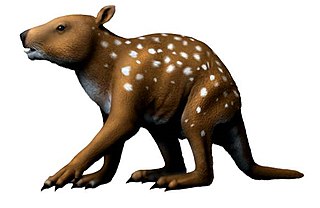
The order Peramelemorphia includes the bandicoots and bilbies. All members of the order are endemic to Australia-New Guinea and most have the characteristic bandicoot shape: a plump, arch-backed body with a long, delicately tapering snout, very large upright ears, relatively long, thin legs, and a thin tail. Their size varies from about 140 grams up to 4 kilograms, but most species are about one kilogram.

Bandicoots are a group of more than 20 species of small to medium-sized, terrestrial, largely nocturnal marsupial omnivores in the order Peramelemorphia. They are endemic to the Australia–New Guinea region, including the Bismarck Archipelago to the east and Seram and Halmahera to the west.

The Hypsiprymnodontidae are a family of macropods, one of two families containing animals commonly referred to as rat-kangaroos. The single known extant genus and species in this family, the musky rat-kangaroo, Hypsiprymnodon moschatus, occurs in northern Australia. During the Pleistocene, this family included the megafauna genus Propleopus.

Thylacoleonidae is a family of extinct carnivorous diprotodontian marsupials from Australia, referred to as marsupial lions. The best known is Thylacoleo carnifex, also called the marsupial lion. The clade ranged from the Late Oligocene to the Late Pleistocene, with some species the size of a possum, while members of Thylacoleo reached sizes comparable to living big cats.

Ekaltadeta is an extinct genus of marsupials related to the modern musky rat-kangaroos. Ekaltadeta was present in what is today the Riversleigh formations in Northern Queensland from the Late Oligocene to the Miocene.
Yarala is a genus of fossil mammals that resemble contemporary bandicoots. The superfamily Yaraloidea and family Yaralidae were created following the discovery of the type species Yarala burchfieldi in 1995, on the basis that it lacks synapomorphies that unite all other peramelemorphian taxa.

Bettongs, species of the genus Bettongia, are potoroine marsupials once common in Australia. They are important ecosystem engineers displaced during the colonisation of the continent, and are vulnerable to threatening factors such as altered fire regimes, land clearing, pastoralism and introduced predatory species such as the fox and cat.

Protemnodon is an extinct genus of megafaunal macropodids that existed in Australia, Tasmania, and New Guinea in the Pliocene and Pleistocene. Members of this genus are also called giant kangaroos.

Propleopus is an extinct genus of marsupials. Three species are known: P. chillagoensis from the Plio-Pleistocene, and P. oscillans and P. wellingtonensis from the Pleistocene. In contrast to most other kangaroos, and similar to their small extant relative, the musky rat-kangaroo, they were probably omnivorous.
Ganguroo is a genus of fossil macropods found at Riversleigh in Australia, material dating from the Middle to Late Miocene Epoch. The type species of the genus is Ganguroo bilamina, published in 1997. Two recently described species, Ganguroo bites and Ganguroo robustiter, have also been placed in this genus.
Galadi is an extinct genus of predatory bandicoot from Oligo-Miocene deposits of Riversleigh, northwestern Queensland, Australia. It was first named by K.J. Travouillon, Y. Gurovich, R.M.D. Beck and J. Muirhead in 2010 and the type species is Galadi speciosus; additional three species, G. adversus, G. amplus and G. grandis, were described in 2013. The genus is represented by three well-preserved skulls and several isolated maxillae and dentaries. Its body mass would have been close to two pounds, making it relatively large for its family. The combination of body size, robustness and short, stout skull indicates that Galadi would have been able to take relatively large prey for its size, though the morphology of its molars indicates it may have been omnivorous.
The Macropodidae are an extant family of marsupial with the distinction of the ability to move bipedally on the hind legs, sometimes by jumping, as well as quadrupedally. They are herbivores, but some fossil genera like Ekaltadeta are hypothesised to have been carnivores. The taxonomic affiliations within the family and with other groups of marsupials is still in flux.
Priscakoala is an extinct genus of koala from the Early Miocene of Riversleigh, Australia. It has one species: Priscakoala lucyturnbullae.
Bulungu is an extinct genus of bandicoot-like mammal from Oligo-Miocene deposits of Riversleigh, northwestern Queensland, and the Etadunna Formation, Australia. It was first named by Gurovich et al. (2013) and the type species is Bulungu palara. Two additional species, Bulungu campbelli and Bulungu minkinaensis, were also described in 2013. Bulungu muirheadae is the oldest fossil bandicoot recovered to date. An additional three species Bulungu minkinaensis, Bulungu pinpaensis, and Bulungu westermani were named by Travouillon, Beck & Case (2021) allowing for placement of the genus in the superfamily Yaraloidea.
Cookeroo is a genus of extinct kangaroos from the Late Oligocene and Early Miocene found in fossil deposits from the Riversleigh World Heritage Area, in Australia. The genus includes two species, C. bulwidarri and C. hortusensis.
Ganawamaya is an extinct genus of quadrupedal kangaroos that lived in Australia.

Notamacropus is a genus of small marsupials in the family Macropodidae, commonly known as wallabies. The term is derived from the Latin nota "stripe" and macropus "kangaroo", referencing the distinct facial stripe of many extant genus members and their phylogenetic relationship to other kangaroos.

Ekaltadeta ima is a species of potoroid marsupial that existed in Miocene Australia.
Ekaltadeta jamiemulvaneyi is a species of potoroid marsupial that existed in later periods of Miocene Australia.
Lekaneleo roskellyae is a fossil species of carnivorous marsupial that existed during the early Miocene in Australia. Once allied to the type species of the genus Priscileo, later placed as Wakaleo pitikantensis, "Priscileo" roskellyae was subsequently transferred to its own genus Lekaneleo.













